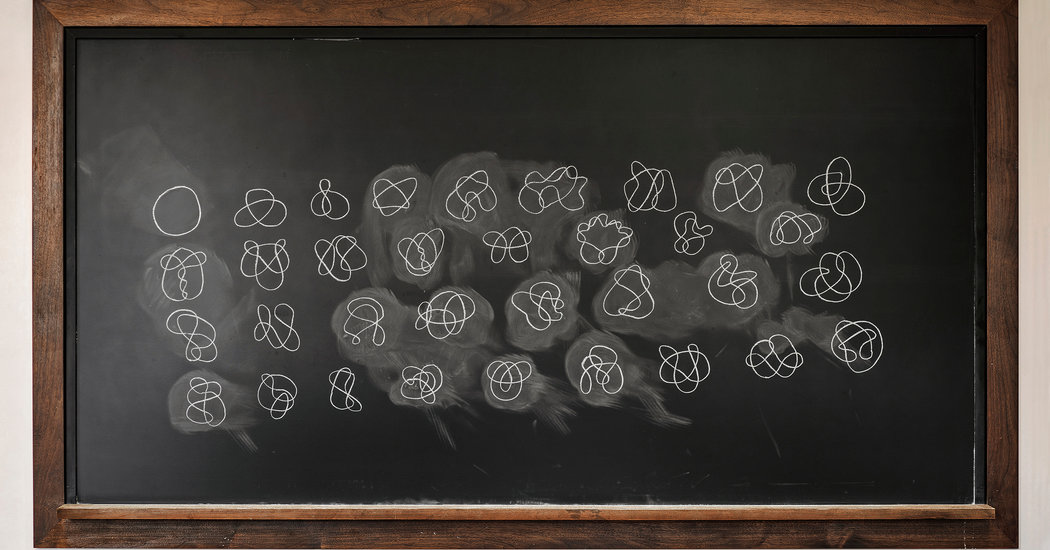This is what thought looks like.
Ideas, and ideas about ideas. Suppositions and suspicions about relationships among abstract notions — shape, number, geometry, space — emerging through a fog of chalk dust, preferably of the silky Hagoromo chalk, originally from Japan, now made in South Korea.
In these diagrams, mysteries are being born and solved.
For the last year, Jessica Wynne, a photographer and professor at the Fashion Institute of Technology in New York, has been photographing mathematicians’ blackboards, finding art in the swirling gangs of symbols sketched in the heat of imagination, argument and speculation. “Do Not Erase,” a collection of these images, will be published by Princeton University Press in the fall of 2020.
“A mathematician, like a painter or poet, is a maker of patterns,” the British mathematician G.H. Hardy wrote in 1940. Ms. Wynne was drawn to math through her summer neighbors on Cape Cod, Amie Wilkinson and Benson Farb, who both teach at the University of Chicago. She began photographing their blackboards and felt an artistic kinship.
“I am attracted to the timeless beauty and physicality of the mathematicians’ chalkboard, and to their higher aspiration to uncover the truth and solve a problem,” Ms. Wynne said in an email. “Their imagination guides them and they see images first, not words. They see pictures before meaning.”
She added: “I am also fascinated by the process of working on the chalkboard. Despite technological advances, and the creation of computers, this is how the masters choose to work.”
In their love of blackboards and chalk, mathematicians are among the last holdouts. In many fields of science and investigation, blackboards have been replaced with whiteboards or slide show presentations. But chalk is cheaper and biodegradable. It smells better than whiteboard markers and is easier to clean up, mathematicians say. It is also more fun to write with.
The title of Ms. Wynne’s book comes from the message often left on blackboards for the cleaners who might come in after hours and wipe away the artifacts of genius: “Do not erase.”
It happens. In a recent article in Nautilus, the writer and M.I.T. physicist Alan Lightman recalled an occasion at Caltech in the early 1970s when Richard Feynman worked out an equation on Lightman’s blackboard that described how black holes could emit heat and radiation, in contravention to everything that physicists then thought.
Dr. Lightman returned the next morning to copy down the equations, but the board had been wiped clean. A year later, Stephen Hawking worked out a similar calculation, which made him famous.
There is more than one way to think on a blackboard, as Ms. Wynne’s photographs demonstrate. Some mathematicians fill the board with equations, a dissertation’s worth of jumps and transitions encoded in one image, as in the geometric musings of Alex Zhongyi Zhang, a doctoral student at Columbia University.
Others are neat and tidy, like a blackboard that Ms. Wynne photographed among the trees at the Institut des Hautes Études Scientifiques outside Paris.
Tadashi Tokieda, a professor at Stanford University, made fun of how mathematicians, restricted to black-and-white imagery on blackboards, always make a white (chalk) dot to represent “black” and an empty circle (which is black) to represent “white.” Mathematicians would get the joke, Ms. Wynne said.
Still other blackboards are indecipherable: clouds of mostly erased confusion or frustration. The quest for knowledge does not always end happily.
Most mathematicians, if asked, would say that in their work they are accessing some Platonic world of ideals that exists independently of our own. Some argue that math is a human construct, a product of our own minds, with which scientists model the apparent rules of reality.
Why it works is a mystery. In a 1960 essay titled “The Unreasonable Effectiveness of Mathematics in the Natural Sciences,” the physicist Eugene Wigner wrote, “The miracle of the appropriateness of the language of mathematics for the formulation of the laws of physics is a wonderful gift which we neither understand nor deserve.”
Mathematics has worked again and again. Half a century before Einstein described gravity as “curved space” in his general theory of relativity, the equations describing curved space had appeared on the blackboards of mathematicians like Georg Friedrich Bernhard Riemann of Gottingen University in Germany.
If you want to know what the universe might look like to certain discerning minds 50 or 100 years from now, watch these spaces.
Dennis Overbye joined The Times in 1998, and has been a reporter since 2001. He has written two books: “Lonely Hearts of the Cosmos: The Story of the Scientific Search for the Secret of the Universe” and “Einstein in Love: A Scientific Romance.” @overbye
Source: Read Full Article





